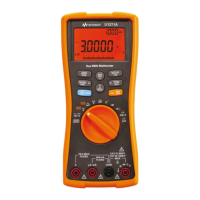1 Introduction
Your Multimeter in Brief
50 U1271A/U1272A User’s Guide
Analog bar graph
The analog bar emulates the needle on an analog multimeter,
without displaying the overshoot. When measuring peak or
null adjustments and viewing fast- changing inputs, the bar
graph provides a useful indication because it has a faster
updating rate
[1]
to cater for fast- response applications.
For frequency, duty cycle, pulse width, 4- 20 mA % scale,
0- 20 mA % scale, dBm, dBV, and temperature measurements,
the bar graph does not represent the primary display value.
For example, when frequency, duty cycle, or pulse width is
displayed on the primary display during voltage or current
measurement, the bar graph represents the voltage or
current value (not the frequency, duty cycle, or pulse width
value). Another example is when 4- 20 mA % scale or
0- 20 mA % scale is displayed on the primary display, the bar
graph represents the current value and not the percentage
value.
The “+” or “–” sign indicates whether the measured or
calculated value is positive or negative. Each segment
represents 1000 or 500 counts depending on the range
indicated on the peak bar graph.
An unstable bar graph and unmatched primary display when
measuring DC voltage usually means the presence of AC
voltages in the circuit.
[1] The analog bar graph measurement rate is approximately 50 times/second for
DC voltage, current, and resistance measurements.
Table 1-10 Analog bar graph display
Range Counts/
Segments
Used for the
function
500 , , ,
1000 , , ,

